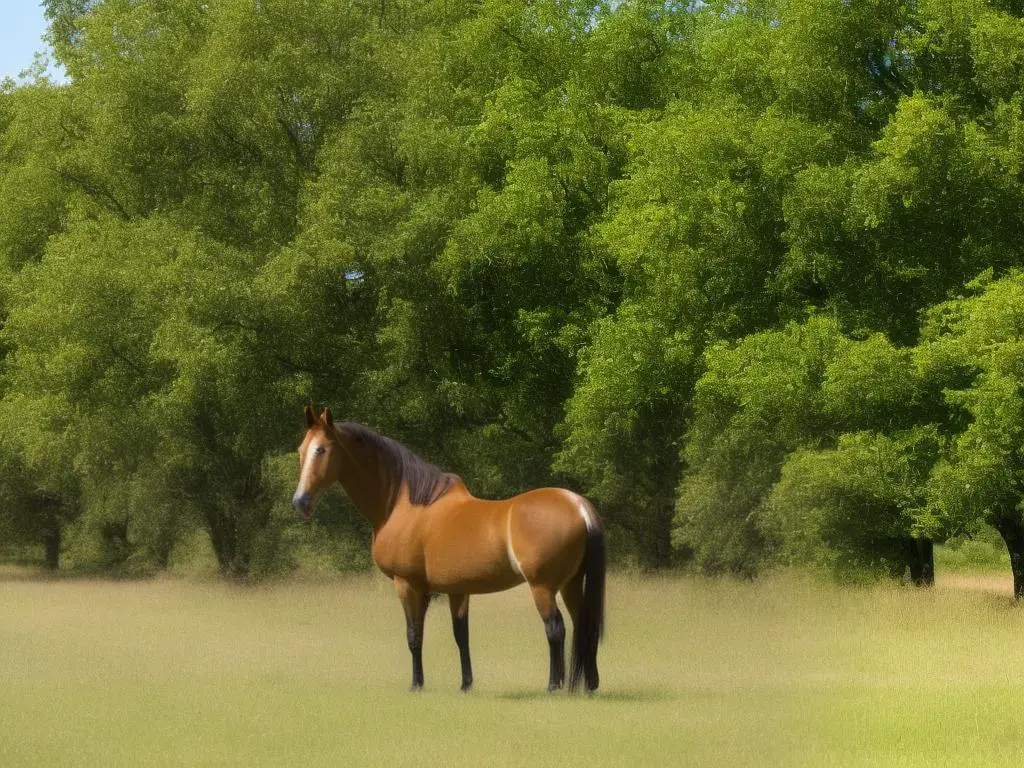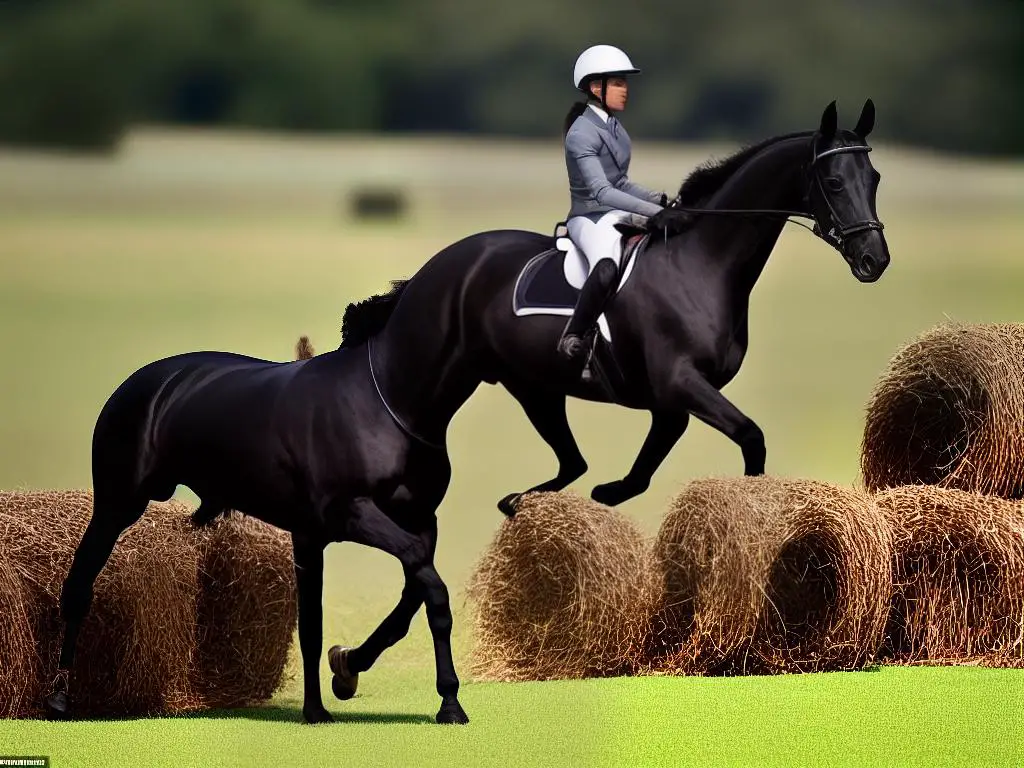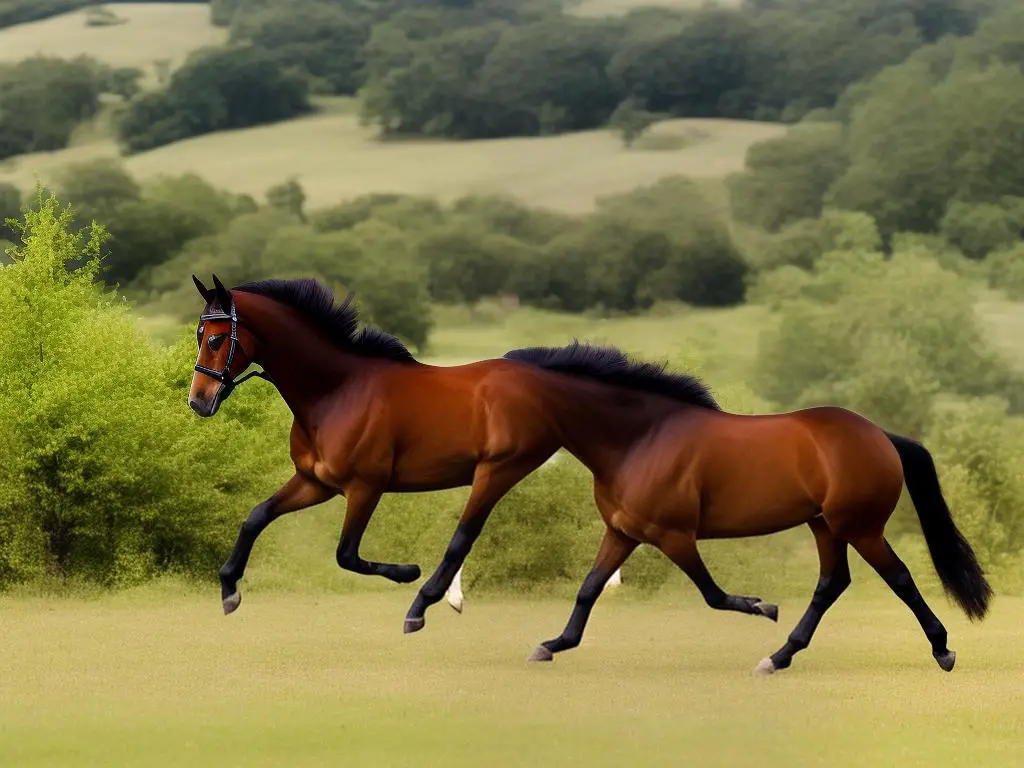From the vast grassy plains of Germany, a breed of outstanding equines emerged, coveted for their robust physique and dynamic versatility – the German Warmbloods. Known for their compelling history that intertwines with the evolution of human civilization, the saga of German Warmbloods is a narrative not only of a breed, but also of a nation’s socio-economic metamorphosis. This essay embarks on an illuminating journey that delves into the origins of this splendid breed, their development, the pivotal role played by studbooks and breeding associations, their significant presence in modern equestrian sports, and the current practices geared towards their conservation. In understanding the past and present of German Warmbloods, readers will gain a profound appreciation of the breed’s enduring legacy and promising future.
Table of Contents (Horspedia)
Origins of German Warmbloods
Origins of German Warmbloods
German Warmbloods are a group of middle-weight horse types that originated in Germany. They were developed for both riding and carriage use. The breed is not antiquated like the Thoroughbred or Arab, but rather, it is a modern creation, refined for specific purposes in the post-war era. Its foundation includes many different regional breeds which were selectively crossbred for the desired traits.
Ancestry of German Warmbloods
Regional horses from various parts of Germany form the basis of the German Warmblood. These breeds include the Oldenburg, Hanoverian, Holsteiner, Trakehner, and Westphalian among others. Many older regional breeds that contributed to these warmbloods have faded into obscurity or are extinct today. However, each of these breeds led to the development of the distinct and high performing warmblood horse we know today.
Origins by Regions
- The Oldenburg originated in the Grand Duchy of Oldenburg.
- The Hanoverian, renowned for its athleticism and versatility, comes from the former Kingdom of Hanover, today a part of Lower Saxony.
- The Holsteiner, one of the oldest warmblood breeds, comes from Schleswig-Holstein.
- The Trakehner, named after the East Prussian town of Trakehnen, known for their endurance and agility, and
- The Westphalian, from the Westphalia region of North Rhine-Westphalia.
Influence of Native and Foreign Breeds
German farmers traditionally kept horses for farm work, transportation, and warfare. The native breed, or Landrace, was a moderate-sized, robust, and versatile horse, capable of both riding and pulling a carriage or plow. In an effort to upgrade these horses for modern uses, breeders infused foreign blood, primarily English Thoroughbred and Arabian. The Thoroughbred influence added speed and endurance, while the Arabian blood added finesse, stamina, and hardiness.
Development into Sport
After the mechanization of agriculture and the rise of motor vehicles, the German Warmblood was no longer needed for farm work or transportation. Breeders shifted their focus to developing a sport horse capable of excelling in show jumping, dressage, and eventing. The German equestrian federation established strict performance tests for horses, which significantly influenced the breed’s development.
Modern German Warmblood
Today the German Warmblood is known as a superior sport horse, excelling in dressage, jumping, and eventing, often winning or placing in international competitions. Each breed society performs rigorous inspections and performance testing to ensure the quality and athleticism of the breed. The German Warmblood is not a breed in its own right, but a type created from a group of closely related breeds, each with their own studbook and breeding goal.
Rich Heritage
The illustrious lineage of German Warmbloods finds its roots in a variety of horse types that played a crucial role in their evolution. Over many generations, careful cross-breeding between local breeds, combined with the introduction of Thoroughbred and Arabian bloodlines, led to the supreme sport horses we see today. Although they’re a relatively recent breed, German Warmbloods have had a profound impact on the equine world. Today, they’re widely recognized and admired for their athletic prowess, adaptability, and commendable temperament.

Breed Development and Use
German Warmbloods
German Warmbloods are renowned horses known for their harmonious balance of power, performance, and grace. The breed’s origins are deeply intertwined with practical demands, sporting aspirations, and the shifting tide of history. To truly appreciate the unique physical attributes and impressive temperament of the modern German Warmblood, it is necessary to understand how both external influences from history and internal breeding advancements have shaped their evolution.
Origin of the German Warmbloods
The German Warmbloods breed has its roots in the Middle Ages, where dependable and robust horses were essential for agriculture, transportation, and warfare. Substantially heavier horses, called “cold-bloods,” were utilized during this era due to their immense capacity for laborious farm work and rigorous military service. However, with the advent of firearms in warfare during the late Middle Ages and the declining need for heavy cavalry horses, there was a growing demand for lighter, faster, yet sturdy horses. This led to the gradual development of the “warmblood” – a horse that was lighter than a draft horse, but more powerful than the lighter riding horses, often known as “hot-bloods”.
Factors Influencing Breed Development
The warmbloods’ physical characteristics were significantly affected by climate, geography, and the local agricultural conditions of Germany. Specific traits such as strong musculature, robust bone structure, and an adaptable nature were highly prized in these horses, as they were deployed in varied terrains and weather conditions.
Germany also imported horses from other parts of Europe, further diversifying the breed’s genetic pool. Notably, oriental stallions were crossbred with local mares, leading to a stronger, more agile variant of the Warmblood – the foundation of today’s German Warmbloods.
Role in Warfare and Work
Throughout the centuries, German Warmbloods have served pivotal roles in military conflicts. Their speed, endurance, and calm temperament made them invaluable war assets. With their sizable build and strength, they were harnessed for heavy artillery transport and were even ridden by the cavalry. This military use influenced their development, resulting in braver and more resilient horses.
Even in peace times, German Warmbloods were extensively employed in farms and factories, contributing to their overall muscular and durable physique.
Transformation into Sport Horses
With the dawn of modern transportation and mechanized farming, the need for work horses diminished. As a result, breeders realigned their focus, evolving the German Warmbloods into sport horses by emphasizing more on agility, stamina, and elegance.
Certain lighter and faster horse breeds, such as the Arabian and Thoroughbred, were purposefully introduced into the bloodline to enhance speed and refine movement. Breed types like the Hanoverian and the Holstein emerged with a reputation for excellence, known for their strength and grace as showjumpers and dressage horses.
Today, German Warmbloods stand as a testament to their robust and flexible heritage. They remain in-demand for equestrian sports and are celebrated for their exceptional movement, jumping prowess, and disciplined temperament. The resilient history of German Warmbloods not only underlines their robustness, adaptability, and prowess as top-flight athletes, but also mirror the evolving bond between humans and horses in their shared quest for a superior balance of strength, elegance, and adaptability.

Impact of Studbooks and Breeding Associations
Selective Breeding and History of German Warmbloods
German Warmbloods, admired for their potent combination of strength, agility and versatility, owe their attributes to centuries of meticulous selective breeding. However, the transformation of this breed into the versatile modern sport horse widely appreciated today can largely be attributed to organized breeding programs. A key component of these programs was the establishment of studbooks and breeding societies. From the Hanoverian to the Westphalian groups, these breeding societies have played a significant role in preserving breed standards and enhancing quality progressively.
Establishment of Studbooks and Breeding Associations
Studbooks for various Warmblood breeds were established during the late 19th and early 20th centuries. These records included information about each horse’s lineage and physical characteristics, helping breeders make informed decisions about future pairing. For example, the Hanoverian Studbook was established in 1888, transforming local horse breeding by introducing modern selection methods based on performance and pedigree analysis.
Another significant organization was the Westphalian Studbook, established in 1904. Similar to the Hanoverian association, this organization played a pivotal role in selectively breeding versatile sport horses. The breeders focused on animals that displayed not only superior physical traits but also impressive athleticism and trainability.
These studbooks and the corresponding breeding associations offered a structured approach to horse breeding, focusing on the systematic improvement of bloodlines. Each association maintained precise records tracing back several generations. This allowed for greater control in managing hereditary traits and enhancing quality.
Implementation of the Performance Test in German Warmblood Breeding
Alongside the establishment of studbooks and breeding associations, another key development was the implementation of the Performance Test in German Warmblood breeding. The Performance Test, also known as the Stallion Performance Test, is a stringent examination that tests a horse’s athleticism, agility, and general performance abilities.
The introduction of the Performance Test resulted in an even greater emphasis on the athletic capabilities of German Warmbloods. Not every horse would make it to the studbook, only those which passed these rigorous tests. This selection pressure led to the enhancement of traits beneficial for sporting events, making the German Warmblood a premier sport horse breed.
Summary
To sum up, the intricate development of German Warmbloods was significantly influenced by the establishment of vital studbooks and purposeful breeding associations such as Hanoverian and Westphalian. These organizations brought about a systematic, structured approach to breeding, utilizing selective pairings to enhance favorable traits. These selections were primarily based on performance and pedigree data. Furthermore, the evolution of the Performance Test played an essential role in perfecting the meticulous selection steps and boosting the breed’s development as a superior sport horse. Together, these systematic efforts paved the way for the distinctive versatile, athletic, and durable German Warmbloods known globally.

Modern German Warmbloods in Equestrian Sports
Contemporary German Warmbloods
Todays’ German Warmbloods symbolize a prime example of dedicated horse breed evolution geared towards equestrian sports. Renowned for their might, grace, and agile athleticism, these horses are preferred for a broad range of equestrian activities, including dressage, show jumping, and eventing. Learning about the rich history of these majestic horses and their immense contribution to these sports helps to deeply appreciate their current global fame and popularity.
Origins and Breeding of German Warmbloods
German Warmbloods are not a breed unto themselves, but instead are a group of horse breeds that originate from Germany. The main breeds include the well-known Hanoverian, the Holsteiner, the Oldenburg, and the Westphalian. The selection and breeding of these horses have been carefully managed over generations, with the specific aim of creating highly athletic horses for sport. The breeding process often involves crossing local mare lines with imported sires known for their performance in equestrian sports.
Prominence in Dressage
Dressage, a highly skilled form of horse training, is one area where German Warmbloods have excelled. Known for their smooth, graceful movement and keen intelligence, these horses have helped many riders achieve noteworthy success in the sport. The Hanoverian, in particular, is revered in dressage due to its ability to master complex movements with grace and ease. One emblematic example is the legendary partnership between German rider Isabell Werth and her Hanoverian mount, Gigolo FRH, who dominated the dressage scene in the 1990s.
German Warmbloods in Show Jumping
Show jumping is another discipline where German Warmbloods, particularly Holsteiners and Westphalians, have demonstrated extraordinary prowess. Their strength, agility, and natural jumping ability have made them highly desirable in this field. Famous jumpers like the Holsteiner gelding, Casall Ask, and the Westphalian mare, Meredith Michaels-Beerbaum’s Shutterfly, have thrilled fans and won numerous awards in international competitions.
Excellence in Eventing
Eventing, which combines dressage, cross-country, and show jumping, requires a horse that is not only versatile but also capable of endurance. German Warmbloods have consistently demonstrated these qualities. The Trakehner, a lighter type of German Warmblood, has shone particularly in this demanding discipline for its stamina, agility, and courage.
Global Recognition and Influence
German Warmbloods’ influence extends beyond the competition ring. They have significantly impacted the breeding strategies of sport horses worldwide, with many countries importing German Warmbloods to improve their local breeds. For instance, the Dutch Warmblood, which stands today as one of the most competitive breeds in international equestrian sports, owes much of its success to the infusion of German Warmblood stock.
Conclusion
German Warmbloods have significantly impacted modern equestrian sports due to their exceptional traits, which have been carefully honed through strategic breeding techniques for specific equestrian events. Their sheer excellence in the competitive arena does not only demonstrate their dominance but also highlights the global influence that these horses have had on sport horse breeding. The numerous accolades and prestigious awards attested to these horses by riders worldwide narrate the journey of success and relevance of German Warmbloods in the equestrian spectrum.

Current Breeding Practices and Conservation
Current Breeding Practices of German Warmbloods
The development and refinement of breeding practices for German Warmbloods over the years is a direct response to the evolving needs of the competitive landscape, coupled with advancements in horse-breeding technology. However, a delicate balance is struck to preserve the historical traits of the breed while introducing new qualities to enhance their competitiveness and adaptability. German horse breeders have consistently upheld a strict selection and breeding policy that ditches quantity in favor of quality, a strategy that has contributed to the widespread popularity of German Warmblood.
Artificial insemination, a common practice in the breeding of these warmbloods, allows wider dissemination of valuable genetic attributes without physical contact. The propagation of desired traits like endurance, athleticism, and favorable temperament can be successfully achieved through this method. Furthermore, breeders also resort to using the embryo transfer technique, particularly for high-value mares who are still engaged in competitive performance while also enriching the breed’s gene pool.
Performance testing is key to the current breeding practices for German Warmbloods. This process enables breeders to assess their horse’s capabilities and qualities – such as performance in dressage, show jumping, and their temperament. Only the standout horses that meet the high testing standards are considered for further breeding, thereby ensuring the consistent quality of German Warmbloods.
Conservation and Challenges
Despite the rigorous breeding regime, the German Warmblood breed faces several challenges today. One of the main concerns is maintaining genetic diversity within the breed. Preserving a breed’s genetic diversity is crucial as it helps prevent genetic defects, promotes robustness and adaptability, and ensures the long-term survival of the breed. The increasing popularity and associated commercial success of few high-performing stallions often lead to overuse, risking the reduction of genetic diversity.
In addition to genetic diversity, disease prevention and control are a significant concern within the breeding community. Advances in genetic testing have allowed breeders to identify and control the transmission of various inheritable diseases. However, the cost-effectiveness and widespread adoption of these measures still remain a challenge. German breeding societies, like Hannoveraner Verband and Holsteiner Verband, have strict regulations in place to monitor, control, and prevent disease transmission, contributing to the health and longevity of the breed.
To overcome these issues and ensure the preservation of the breed, efforts are being made to promote conservation breeding. Conservation breeding focuses on maintaining the breed’s historical traits while increasing its genetic diversity. This is achieved by promoting lesser-known but genetically diverse stallions and supporting the breeding of traditional bloodlines.
Moreover, sperm and embryo storage are increasingly being utilized as part of conservation efforts. This practice enables the preservation of the breed’s genetics, even allowing the resurrection of a bloodline in the future.
Conclusion
Overall, the history and current breeding practices of German Warmbloods highlight a constant endeavor for balance. The breeding practices that are in place aim to retain the exceptional qualities of the breed while ensuring its sustainability and genetic diversity. The journey has been a testament to the tenacity of breeders and the resilience of these magnificent animals, with continuous efforts being made to adapt to new challenges and preserve the integrity of German Warmbloods. Careful breeding strategies and technological advancements are important factors in sustaining the superior performance and legacy of these horses.

In essence, German Warmbloods have left an indelible mark not only in history but also in the equestrian world. Their undeniably rich lineage, coupled with their admirable traits and performance, have catapulted them to a celebrated global status. The establishment of studbooks and breeding associations have acted as crucial guardians, ensuring the breed’s pure lineage and quality. With consistent success on the competitive scene, German Warmbloods remain some of the most respected athletes in equestrian sport. However, maintaining this distinction requires concerted efforts to uphold sustainable breeding practices and promote genetic diversity. The future of German Warmbloods stands at the intersection of respect for their illustrious past and the need for modern breeding techniques, making their story a continuous saga of resilience, adaptation, and enduring excellence.
